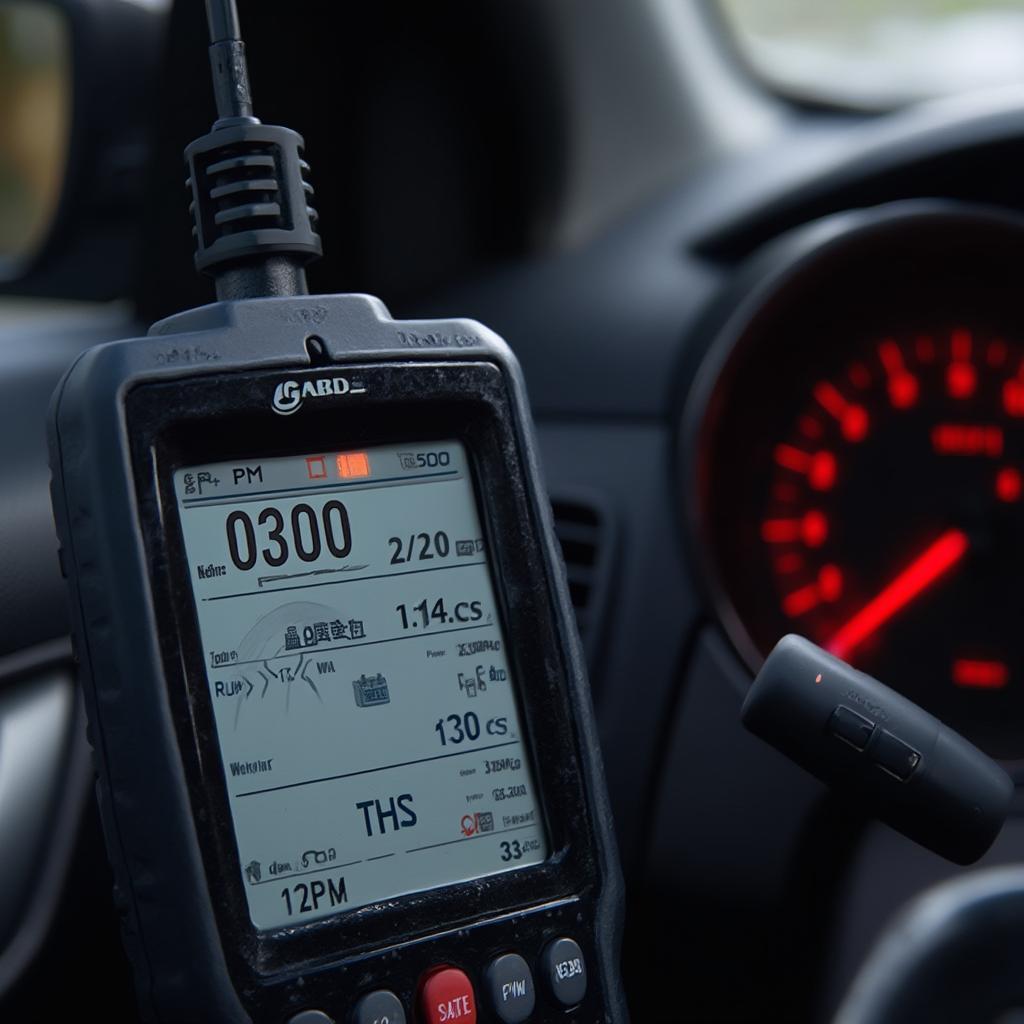The dreaded “obd2 0 300” code can be a source of frustration for any car owner. This code indicates a random or multiple cylinder misfire, a problem that can significantly impact your vehicle’s performance and fuel efficiency. Understanding this code, its causes, and potential solutions is crucial for getting your car back on the road smoothly.
 OBD2 Scanner Displaying P0300 Code
OBD2 Scanner Displaying P0300 Code
What Does OBD2 0 300 Mean?
The OBD2 code P0300 specifically refers to a random or multiple cylinder misfire detected by your car’s onboard diagnostic system. Unlike codes like P0301 (cylinder 1 misfire) or P0302 (cylinder 2 misfire), P0300 doesn’t pinpoint a specific cylinder. This can make diagnosing the issue slightly more complex, but it doesn’t mean it’s unsolvable. Essentially, the code signifies that the engine’s cylinders aren’t firing correctly, leading to a rough idle, reduced power, and potentially increased emissions.
Common Causes of OBD2 0 300
Several factors can trigger a P0300 code. These range from relatively simple fixes like worn spark plugs to more complex issues like vacuum leaks or faulty fuel injectors. Here are some of the most common culprits:
- Worn Spark Plugs: Spark plugs ignite the air-fuel mixture in the cylinders. If they’re worn or fouled, they can misfire.
- Faulty Ignition Coils: Ignition coils provide the high voltage necessary for the spark plugs to fire. A failing coil can cause misfires in one or more cylinders.
- Vacuum Leaks: Leaks in the intake manifold or vacuum hoses can disrupt the air-fuel mixture, leading to misfires.
- Fuel Injectors: Malfunctioning fuel injectors can disrupt the fuel delivery to the cylinders, resulting in a lean or rich mixture and potential misfires.
- Oxygen Sensors: Faulty oxygen sensors can provide incorrect information to the engine control unit (ECU), leading to an improper air-fuel mixture and misfires.
Diagnosing and Fixing OBD2 0 300
Diagnosing a P0300 code requires a systematic approach. Here’s a suggested process:
- Check for any other codes: Sometimes, a P0300 code can be accompanied by other codes that can help pinpoint the issue. Using an foxwell nt300 obd2 can help you identify all present codes.
- Inspect the spark plugs: Check for signs of wear, fouling, or damage. Replace them if necessary.
- Check the ignition coils: Test the coils using a multimeter or swap them between cylinders to see if the misfire follows the coil.
- Inspect for vacuum leaks: Use a vacuum gauge or a smoke test to identify any leaks in the intake manifold or vacuum hoses.
- Check the fuel injectors: Test the injectors for proper operation and replace them if necessary.
- Check the oxygen sensors: Test the sensors using a multimeter or an OBD2 scanner and replace them if necessary.
“A thorough diagnostic process is key when dealing with P0300,” says John Smith, a certified ASE Master Technician. “Jumping to conclusions can lead to unnecessary repairs and wasted time.”
What if the Problem Persists?
If you’ve checked all the common causes and the P0300 code persists, it’s time to seek professional help. A qualified mechanic has the tools and expertise to diagnose more complex issues, such as problems with the engine control unit (ECU) or mechanical issues within the engine itself.
riorand rs300 can diagnostic scan tool for obdii obd2 vehicles can be a good starting point for your diagnosis.
Conclusion
The obd2 0 300 code, while potentially concerning, is often resolvable. By understanding its meaning, common causes, and diagnostic procedures, you can take the necessary steps to address the issue and restore your vehicle’s performance. Don’t let a P0300 code keep you off the road.
FAQ
- What is the most common cause of a P0300 code? Worn spark plugs are often the culprit.
- Can I drive my car with a P0300 code? It’s best to address the issue as soon as possible to avoid further damage.
- How much does it cost to fix a P0300 code? The cost varies depending on the underlying cause.
- Can a bad fuel pump cause a P0300 code? While less common, a failing fuel pump can contribute to misfires.
- Is a P0300 code serious? It can be, as it indicates a problem with the engine’s combustion process.
- How can I prevent a P0300 code? Regular maintenance, including spark plug replacements, can help prevent misfires.
- What are the symptoms of obd2 0 300? Rough idle, reduced power, and potentially a check engine light.
Scenarios for P0300
- Scenario 1: Car starts roughly and shakes at idle. Check engine light is on. Possible cause: Worn spark plugs.
- Scenario 2: Car hesitates under acceleration. Check engine light is flashing. Possible cause: Faulty ignition coil.
- Scenario 3: Engine runs rough and fuel economy is poor. Check engine light is on. Possible cause: Vacuum leak.
For more information on specific car models and their OBD2 codes, check out our article on obd2 code p0300 ford 2006 f250 5.4l. You might also find our article on 1987 nissan 300zx turbo obd2 port helpful.
Need support? Contact us via WhatsApp: +1(641)206-8880, Email: [email protected] or visit us at 789 Elm Street, San Francisco, CA 94102, USA. Our customer service team is available 24/7.

